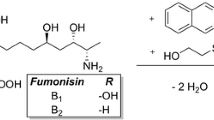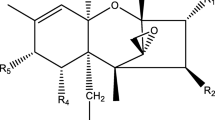Abstract
A rapid, sensitive and validated method for the determination of fusaric acid (FA) in several Fusarium strains and different commercial food and feed products is reported based on ultra-performance liquid chromatography. This method requires only crude sample by a simple extraction with methanol, and requires a very short time of 8 min for completion. Separation of FA was performed at injection volume of 1 μl with a 20:80 (v/v) water/acetonitrile mobile phase containing 0.1 % formic acid at a flow rate of 0.05 ml/min and detected with UV at 220 nm. Nice linearity and good correlation coefficient (R2 > 0.99) were obtained in the concentration range of 1–200 μg/ml. Validation was demonstrated using blank samples spiked at three different concentrations with standard solution, and the method yielded more than 98.2 % recovery efficiencies and below 2.56 % R.S.D. when applied in the analysis of FA produced by Fusarium verticillioides and a set of transgenic strains of this fungus. Satisfactory recoveries in the range of 79.1–105.8 % and R.S.D lower than 10 % were also obtained for the tested commercial food and feed products. The concentration FA detection in the transgenic strains ranged from 9.65 to 135 μg/kg (0.29–4.05 μg per gram of biomass). However, FA was not detected in most of the commercial products with the exception of niblet, oatmeal, red kidney bean and soybean, for which the concentrations of FA ranged from 2.5 to 18 μg/kg (below the permitted maximum). These results show that the proposed method has a great potential application to analyze FA from different sources rapidly.






Similar content being viewed by others
References
Brown DW, Butchko RA, Busman M, Proctor RH (2012) Identification of gene clusters associated with fusaric acid, fusarin, and perithecial pigment production in Fusarium verticillioides. Fungal Genet Biol 49:521–532. doi:10.1016/j.fgb.2012.05.010
Bacon CW, Porter JK, Norred WP, Leslie JF (1996) Production of fusaric acid by Fusarium species. Appl Environ Microb 62:4039–4043. http://www.ncbi.nlm.nih.gov/pubmed/8899996
Sundararajan KS, Subbaraj R, Chandrashekaran MK, Shunmugasundaram S (1978) Influence of fusaric acid on circadian leaf movements of the cotton plant, Gossypium hirsutum. Planta 144:111–112. doi:10.1007/BF00385016
Jiao J, Zhou B, Zhu X, Gao Z, Liang Y (2013) Fusaric acid induction of programmed cell death modulated through nitric oxide signalling in tobacco suspension cells. Planta 238:727–737. doi:10.1007/s00425-013-1928-7
Dong X, Ling N, Wang M, Shen Q, Guo S (2012) Fusaric acid is a crucial factor in the disturbance of leaf water imbalance in Fusarium-infected banana plants. Plant Physiol Biochem 60:171–179. doi:10.1016/j.plaphy.2012.08.004
Ghag SB, Shekhawat UK, Ganapathi TR (2014) Native cell-death genes as candidates for developing wilt resistance in transgenic banana plants. AoB Plants 6:1037–1049. doi:10.1093/aobpla/plu037
Wang M, Sun Y, Sun G, Liu X, Zhai L, Shen Q, Guo S (2015) Water balance altered in cucumber plants infected with Fusarium oxysporum f. sp. cucumerinum. Sci Rep 5:7722–7729. doi:10.1038/srep07722
Li C, Zuo C, Deng G, Kuang R, Yang Q, Hu C, Sheng O, Zhang S, Ma L, Wei Y, Yang J, Liu S, Biswas MK, Viljoen A, Yi G (2013) Contamination of bananas with beauvericin and fusaric acid produced by Fusarium oxysporum f. sp. cubense. PLoS One 8:70226–70237. doi:10.1371/journal.pone.0070226
Shimshoni JA, Cuneah O, Sulyok M, Krska R, Galon N, Sharir B, Shlosberg A (2013) Mycotoxins in corn and wheat silage in Israel. Food Addit Contam Part A 30:1614–1625. doi:10.1080/19440049.2013.802840
Saremi H, Okhovvat SM (2006) Mycotoxin producing Fusarium species associated with plant disease on potato, wheat, corn and animal diseases in northwest Iran. Commun Agric Appl Biol Sci 71:1175–1185. http://www.ncbi.nlm.nih.gov/pubmed/17390876
Smith TK, McMillan EG, Castillo JB (1997) Effect of feeding blends of Fusarium mycotoxin-contaminated grains containing deoxynivalenol and fusaric acid on growth and feed consumption of immature swine. J Anim Sci 75:2184–2191. http://www.ncbi.nlm.nih.gov/pubmed/9263067
Lindner G, Grosse G (1986) The effect of fusaric acid on nerve tissue cultured in vitro. Mikrosk Anat Forsch 100:262–272. http://www.ncbi.nlm.nih.gov/pubmed/3487895
Smith TK, MacDonald EJ (1991) Effect of fusaric acid on brain regional neurochemistry and vomiting behavior in swine. J Anim Sci 69:2044–2049. http://www.ncbi.nlm.nih.gov/pubmed/1712354
Porter JK, Bacon CW, Wray EM, Hagler WM Jr (1995) Fusaric acid in Fusarium moniliforme cultures, corn, and feeds toxic to livestock and the neurochemical effects in the brain and pineal gland of rats. Nat Toxins 3:91–100. doi:10.1002/nt.2620030206
Velasco M, Gilbert CA, Rutledge CO, McNay JL (1975) Antihypertensive effect of a dopamine beta hydroxylase inhibitor, bupicomide: a comparison with hydralazine. Clin Pharmacol Ther 18:145–153. http://www.ncbi.nlm.nih.gov/pubmed/1097150
Wang H, Ng TB (1999) Pharmacological activities of fusaric acid (5-butylpicolinic acid). Life Sci 65:849–856. http://www.ncbi.nlm.nih.gov/pubmed/10465344
Swamy HV, Smith TK, Karrow NA, Boermans HJ (2004) Effects of feeding blends of grains naturally contaminated with fusarium mycotoxins on growth and immunological parameters of broiler chickens. Poult Sci 83:533–543. http://www.ncbi.nlm.nih.gov/pubmed/15109051
Voss KA, Porter JK, Bacon CW, Meredith FI, Norred WP (1999) Fusaric acid and modification of the subchronic toxicity to rats of fumonisins in F. moniliforme culture material. Food Chem Toxicol 37:853–861. http://www.ncbi.nlm.nih.gov/pubmed/10506009
Appell M, Jackson MA, Wang LC, Ho CH, Mueller A (2014) Determination of fusaric acid in maize using molecularly imprinted SPE clean-up. J Sep Sci 37:281–286. doi:10.1002/jssc.201301065
Amalfitano C, Pengue R, Andolfi A, Vurro M, Zonno MC, Evidente A (2002) HPLC analysis of fusaric acid, 9,10-dehydrofusaric acid and their methyl esters, toxic metabolites from weed pathogenic Fusarium species. Phytochem Anal 13:277–282. doi:10.1002/pca.648
Yamashita K, Yamazaki K, Komatsu S, Numazawa M (2010) Fusaric acid as a novel proton-affinitive derivatizing reagent for highly sensitive quantification of hydroxysteroids by LC-ESI-MS/MS. J Am Soc Mass Spectrom 21:249–253. doi:10.1016/j.jasms.2009.10.008
Li J, Jiang G, Yang B, Dong X, Feng L, Lin S, Chen F, Ashraf M, Jiang Y (2012) A luminescent bacterium assay of fusaric acid produced by Fusarium proliferatum from banana. Anal Bioanal Chem 402:1347–1354. doi:10.1007/s00216-011-5546-6
Ventura M, Guillen D, Anaya I, Broto-Puig F, Lliberia JL, Agut M, Comellas L (2006) Ultra-performance liquid chromatography/tandem mass spectrometry for the simultaneous analysis of aflatoxins B1, G1, B2, G2 and ochratoxin A in beer. Rapid Commun Mass Spectrom 20:3199–3204. doi:10.1002/rcm.2723
Waskiewicz A, Beszterda M, Bocianowski J, Golinski P (2013) Natural occurrence of fumonisins and ochratoxin A in some herbs and spices commercialized in Poland analyzed by UPLC-MS/MS method. Food Microbiol 36:426–431. doi:10.1016/j.fm.2013.07.006
Kostelanska M, Zachariasova M, Lacina O, Fenclova M, Kollos AL, Hajslova J (2011) The study of deoxynivalenol and its masked metabolites fate during the brewing process realised by UPLC-TOFMS method. Food Chem 126:1870–1876. doi:10.1016/j.foodchem.2010.12.008
Noser J, Schneider P, Schmutz H, Rother M (2011) Determination of 6 Alternaria toxins with UPLC-MS/MS and their occurrence in tomatoes and tomato products from the Swiss market. Mycotoxin Res 27:265–271. doi:10.1007/s12550-011-0103-x
Lattanzio VMT, Solfrizzo M, Powers S, Visconti A (2007) Simultaneous determination of aflatoxins, ochratoxin A and fusarium toxins in maize by liquid chromatography/tandem mass spectrometry after multitoxin immunoaffinity cleanup. Rapid Commun Mass Spectrom 21:3253–3261. doi:10.1002/rcm.3210
Commission EU (2006) Commission Regulation (EC) No.1881/2006 of 19th December 2006. Setting maximum levels for certain contaminants in foodstuffs. Off J Eur Union L364:15–24. http://ec.europa.eu/food/safety/animal-feed/index_en.htm
Commission regulation on the presence of T-2 and HT-2 toxin in cereals and cereal products (2013). Commission Regulation (EC) 2013/165/EU, Off J Eur Union L91:12–15. http://ec.europa.eu/food/safety/animal-feed/index_en.htm
Acknowledgments
This work was financially supported by the National Natural Science Foundation of China (No. 31070053). The authors gratefully acknowledge the staff of microbiology laboratory of Fujian Normal University.
Author information
Authors and Affiliations
Corresponding author
Ethics declarations
Conflict of interest
The authors declare that they have no conflict of interest.
Rights and permissions
About this article
Cite this article
Chen, Z., Luo, Q., Wang, M. et al. A Rapid Method with UPLC for the Determination of Fusaric Acid in Fusarium Strains and Commercial Food and Feed Products. Indian J Microbiol 57, 68–74 (2017). https://doi.org/10.1007/s12088-016-0617-1
Received:
Accepted:
Published:
Issue Date:
DOI: https://doi.org/10.1007/s12088-016-0617-1




